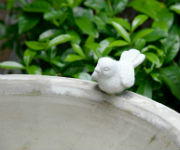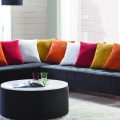
Source: Flickr
What is the best rug for each room in the house? Choosing the right rug can add warmth, texture, and style to your home. We share expert tips for choosing the perfect rug for your home, from the size to the type of material and how to position, place, and style one in any room.
Here are several main factors to keep in mind when choosing an area rug for your space.
Table of Contents
How to choose the right rug size
There are several factors to consider when choosing the right rug, including the size of the room, the layout of furniture, and personal preferences. The main purpose of the rug is to build imaginary boundaries, which visually separate different areas of the room that serve various purposes. Consider these general guidelines when selecting a rug size:
- Measure the room: The first step in finding the right rug size is to measure the room and the furniture in each room. Remember alcoves, doorways, and other obstructions.
- Placement of furniture: Decide where and how you want to arrange your furniture. An area rug should be large enough to accommodate all furniture legs. Ideally, a rug for a dining room should be large enough for the table and chairs to move freely around it.
- Room edges and rug sizes: When choosing a rug size, leave some space around the room's edges. You should leave at least 8 inches (20 cm) of floor visible on all sides, depending on the size of the room and the furniture placement.
- Consider Proportions: Choose a rug proportionate to the room's size and furniture. Large rugs can overwhelm a small space, while small rugs in large rooms can feel disjointed.
Your personal preference will ultimately determine the size of the rug you choose. Feel free to go for a larger rug if that's what you like better.
How do you match a room to a rug?
Rugs must be matched to rooms based on several factors, including the room's size, style, and colour scheme, as well as the rug's size, pattern, and texture.
If your primary furniture, such as a sofa, is solid-coloured, consider selecting a patterned rug. Your sofa should match the secondary colour in a patterned rug. You can match the third rug colour to your room's pillows, drapes, wall colour, or other accents. Here are some steps to help you match a room to a rug:
What should rug match in living room?
Your room shape should define the rug size and orientation to make the space look more extensive and feel connected. Select a rug colour that complements your furniture and décor. And with all furniture legs stepping at the edge of the rug, you will combine the pieces and create a formed seating area.
What kind of rugs are best for a dining room?
Choose easy-to-clean materials like wool and synthetics or even an outdoor rug. With washable rugs, polyester and wool are your best bet for durability, ease of cleaning, and softness. The main rule you should follow when it comes to choosing a dining room area rug is to make sure the chairs are still on the rug even when pushed back. Don’t forget to take into consideration the extendable leaves, if you use them frequently.
What is the best kind of rug for a bedroom?
As bedrooms are typically low-traffic they are a great place for plush, high-pile or even shag rugs to add a luxurious touch to your bedroom. It’s just a cosier feeling than stepping on a cold hardwood floor. Therefore, make sure that the area rug in your bedroom extends a few inches beyond the edge of your bed.
Are rugs in kitchens a good idea?
Rugs are a great addition to any kitchen. They add colour to a neutral-toned kitchen and cushion your feet in a space where you spend most of your time standing. A smaller rug finds its place in front of the sink till a well-placed runner can visually extend space and fits well with long counters. If you have a large kitchen, don’t hesitate to place a round rug in the middle. And remember, the larger the room is, the more you should cover up to make sure the space feels balanced.
Runner rugs for hallways
Your hallways are high-traffic areas so you should protect the flooring from intense wear and tear. Placing a runner in your corridor will help create a clear path from one room to the next. Hallway runners should help define the path of the hallway, but they should never cover the entire space. It's best to leave all furniture legs off the rug in this space.
The benefits of using area rugs
One of the biggest incentives to buy a smaller area rug is, of course, its smaller price. Here are some other benefits of using area rugs for layering.
- Add style to a room. In case you have a bigger carpet (with a neutral or not-so-interesting and engaging pattern) you can lay a smaller, but livelier area rug on top of it. The result will be an out-of-the-box stacked design idea that fits every room, especially the living room.
- Define the space. If you have a large interior space like a living room joined with a kitchen, you can break that space up by layering rugs. Just place an area rug on top of the carpet to create a border between the two spaces.
- Easy maintenance. A great benefit of layering is that it will ease both hot water extraction and dry rug cleaning.
- Protect the floor below. Place a rug over your expensive carpet to help catch stains and conserve the flooring. And when the area rug gets dirty, you can easily change it or give it an easy cleanup.
- Add wonderful textures. Using different kinds of textures through your decor creates a level of depth and a chic look especially if it’s focused on one colour or tone. Placing an area rug made from faux fur, jute or sisal is a great way to add a new texture very obviously.
- Add colour to your room. You can diversify the entire look of a one-coloured room just by layering. The only thing you need to do is to place a brightly coloured area rug on top of your neutral carpet.
How do you tell a good quality rug?
There are several factors to consider to determine the quality of a rug. When choosing a rug, keep these things in mind:
- Materials: A high-quality rug is made from natural materials like wool, silk, or cotton. These materials are durable, long-lasting, and hold their shape well over time.
- Knot count: Knot count refers to the number of knots per square inch. A higher knot count generally indicates a higher quality rug. The knots should be tight and uniform.
- Thickness: The thickness of a rug can also be an indicator of quality. A high-quality rug will feel thick and dense underfoot, indicating a good pile density.
- Design: A well-designed rug will have clear and distinct patterns, with no blurred lines or bleeding colours. The colours should be rich and vibrant without fading.
- Finishing: The finishing of a rug should be neat and tidy. The edges should be straight and even, and the fringes should be securely attached.
When looking for a good quality rug, paying attention to the materials, knot count, thickness, design, finishing, and brand is important. By considering all of these factors, you can ensure that you get a rug that will look beautiful and last for many years.
Does your carpet need a deep cleaning?
Enter your postcode to view our rates and availability in your area.
For questions about the services we offer visit our main site









Leave a Reply